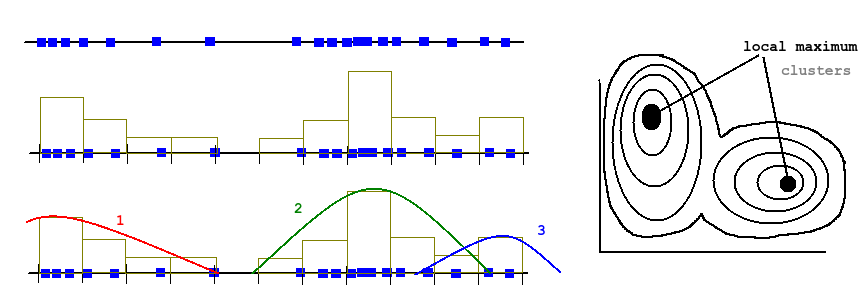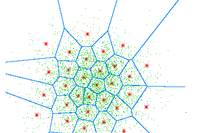Clustering
20 feb. 2013Tags: Youtube
Clustering is an unsupervised meaning we don't know the correct classification or value. In other words, we are trying to group "similar" things. Similar could be measured with many different distance / similarity measures.
We separate between hierarchical and partitional methods. Hierarchical vs partitional clustering.
Hierarchical
"Try all combinations of everything" - very computational expensive, but we can afterwards build a tree and decide then how many clusters we would like.
Can be bottom up: Group two most similar things until all things are grouped (Agglomerative). It can also be top down: group everything and split up most dissimilar things until all things are in individual clusters (divisive).

Partitional
Since we got limited computational resources, we can make some trade off's: We decide on number of cluster (k) and we only calculate the distance for every sample to the current cluster centroid (center), then have the centroid grab (sample choose) the closest distances. Then we move the centroid to the average position of whatever the centroid grabbed. This is called k-means.

K-means by Andrew Hg (Stanford)
A variation on k-means is the c-means. It's a fuzzy algorithm meaning cluster boundaries are not binary, but instead each sample belongs to each centroid with a percentage (probability).
Tree more methods were mentioned during lecture:
Gaussian mixture model: This is actually a density estimation algorithm.
www2.it.lut.fi/project/gmmbayes/


Vector quantization: ???
data-compression.com/vq
Canopy clustering: ???
cwiki.apache.org/MAHOUT/canopy-clustering
Hierartical clustering (Agglomerative)
import sys
import math
import itertoolsdef minkowski(a, b, degree, weights):
degree = float(degree)
if degree < 1:
print('Minkowski: Not defined for lambda less than 1')
sys.exit(1)
result = 0.0
dimensions = len(a)
if dimensions != len(b):
print('Minkowski: Samples are not of same dimensionality')
sys.exit(1)for d in range(dimensions):
result += math.pow(float(weights[d]), degree) * math.pow(math.fabs(float(a[d]) - float(b[d])), degree)return math.pow(result, (1 / degree))
def eucledian(a, b):
return minkowski(a, b, 2, [1] * len(a))def cityblock(a, b):
return minkowski(a, b, 1, [1] * len(a))def merge(a, b):
dimensions = len(a)
if dimensions == len(b):
result = []
for d in range(dimensions):
result.append(float(a[d]) - ((float(a[d]) - float(b[d])) / 2))
return result
else:
print('Merge: Samples are not of same dimensionality')
sys.exit(1)def print_samples(samples):
string = ''
for s in samples:
string += '%s=%s ' % (s['id'], s['data'])
return stringsamples = [
{'id': 'a', 'data': [3, 4]},
{'id': 'b', 'data': [4, 5]},
{'id': 'c', 'data': [9, 6]},
{'id': 'd', 'data': [10, 3]},
{'id': 'e', 'data': [11, 1]},
{'id': 'f', 'data': [4, 2]},
]
print('Starting clusters: %s') % print_samples(samples)while len(samples) > 1:
# 1 calculate all current combinations of distances
combinations = itertools.combinations(range(len(samples)), 2) # get combinations of two from sample range (want indexes)
similarities = []
for c in combinations:
a = samples[c[0]]['data']
b = samples[c[1]]['data']
similarities.append([eucledian(a, b), c])most_similar = sorted(similarities)[0][1] # the two most similar samples
id_first = samples[most_similar[0]]['id']
id_second = samples[most_similar[1]]['id']
print('Most similar: %s and %s') % (id_first, id_second)# 2 merge the two with smallest distance
new_cluster = merge(samples[most_similar[0]]['data'], samples[most_similar[1]]['data'])
samples.append({'id': id_first + id_second, 'data': new_cluster})
indices = most_similar[0], most_similar[1]
samples = [i for j, i in enumerate(samples) if j not in indices]
print('New clusters: %s') % print_samples(samples)

